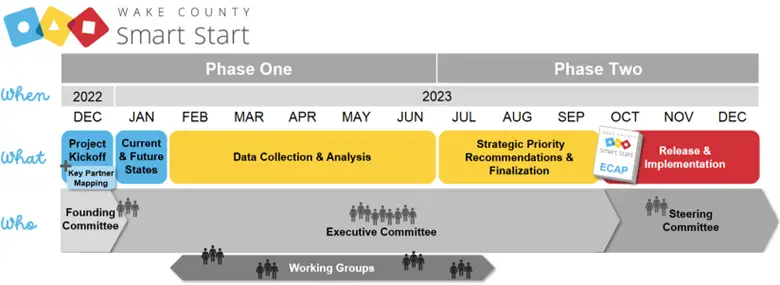
Building a Community-Driven Early Childhood Development Action Plan in Wake County
The Wake County Early Childhood Action Plan (ECAP) is a bold initiative to ensure that every child in Wake County has the opportunity to thrive from birth through early childhood. Recognizing the different needs of the community, the ECAP aims to create a supportive environment for all children and their families.
To achieve this ambitious goal, Wake County Smart Start, the organization leading the initiative, adopted a community-driven, collaborative impact model to ensure that the plan reflected the voices and needs of those it intended to serve. Engaging the community in an intentional, sustained way was critical to creating an effective early childhood development plan.
To support the development and implementation of such a complex model, Smart Start sought a partner with deep knowledge of research-based practices in community engagement and collaborative impact. RTI International was selected to guide the process, helping to turn the vision of a community-driven plan into a reality.
In this blog post, we explore how RTI worked alongside Wake County Smart Start to develop the ECAP, highlighting the strategies used, the obstacles faced, and the lessons learned. We focus on the real-world application of a collaborative impact model and the importance of grounding such efforts in research to achieve meaningful, lasting change.
The Genesis and Vision of the Wake County ECAP
The North Carolina ECAP, launched as a statewide initiative to promote healthy early childhood development, significantly influenced Wake County Smart Start’s efforts. The state plan, designed to empower counties to create tailored strategies for children from birth to age 8, underscored the potential of localized, data-driven approaches. Inspired by this success, Smart Start sought to implement a similar initiative in Wake County to provide local children and families with the support they need to thrive.
With foundational support in place, Smart Start initially attempted to align its ECAP with the state’s framework. However, it soon became clear that a more robust approach was needed to address the complex needs of a county as large as Wake. Rather than following the state’s model, the team adapted a collaborative impact model in which the community itself would drive the plan’s development. Research has shown that collaborative impact models, which rely on cross-sector partnerships and shared ownership, are particularly effective in addressing complex social challenges by fostering collective action and ensuring that solutions are responsive to local contexts (Kania & Kramer, 2011).
Realizing the importance of centering community voices, Smart Start sought RTI’s expertise in community engagement and strategic planning. The goal was to create a plan that reflected the needs of the community and was built on a foundation of shared leadership. By grounding the process in a collaborative impact model, Smart Start aimed to create an ECAP that is sustainable and transformative, driven by the collective vision of the Wake County community.
The Collaborative Process Behind ECAP: From Vision to Reality
To create the ECAP, RTI implemented a structured process that focused on engaging all voices and making data-driven decisions. The Executive Committee and specialized Working Groups were critical to ensuring that the plan was both community-driven and evidence-based. Figure 1 illustrates the committee structure and the function of each group, highlighting when they were most active throughout the ECAP process and their contributions from initiation to implementation.

Figure 1. Committee Structure and Timeline for the Wake County ECAP Process
Executive Committee Structure and Function
The Executive Committee was composed of professionals and community members with expertise and lived experience in early childhood development. This group set the strategic direction of the ECAP, selecting five key Priority Areas: Healthy; Safe and Nurtured; Learning and Ready to Succeed; Empowering Families and Building Community; and Basic Needs. By identifying these five areas, the Executive Committee ensured that the ECAP would address the most critical needs of Wake County’s children and families.
The Committee’s work was grounded in a commitment to involving families and community members in decision-making. This approach aligns with research by Ishimaru (2019), who argues that systemic practices that leverage family expertise can enhance outcomes by ensuring that plans are shaped by the people they are intended to serve. By engaging families as partners, not just beneficiaries, the Executive Committee ensured that the ECAP reflected community priorities and values.
The Committee also established a working group for each priority area, ensuring data, community feedback, and specialized knowledge informed the plan. The Executive Committee provided oversight throughout the process, reviewing the work of the Working Groups to finalize themes, objectives, and suggested actions.
Working Groups and Community Engagement
The Working Groups brought together professionals and community members with expertise in each Priority Area. These groups conducted listening sessions, focus groups, and surveys to gather input from diverse voices across the community. For example, the “Healthy” Working Group surveyed local pediatricians to assess how they screened for social determinants of health, providing valuable data to guide healthcare-related recommendations.
RTI supported the Working Groups by facilitating community asset mapping, helping to identify strengths already present in Wake County. Research shows that approaches rooted in community assets, as described by Blitz et al. (2013), empower communities to leverage their own resources for sustainable change. By focusing on family and community expertise, as Ishimaru (2019) suggests, the Working Groups were able to design strategies that were theoretically sound and practically aligned with the community’s strengths and realities.
Challenges and Solutions in Building the ECAP
As RTI and Smart Start developed the Wake County ECAP, we faced challenges that ultimately shaped the way we engaged with the community, and the lessons learned along the way strengthened the project. Below are some of the key challenges we encountered and how we addressed them.
Building and Maintaining Trust in the Community
Building trust was another key challenge. Community members, sometimes skeptical of new initiatives, needed to see that their input would genuinely shape the outcomes. A key strategy involved empowering members of the empowering families working group to lead focus group conversations in Spanish at the Catholic Charities of the Diocese of Raleigh. Working group members consisted of community-based organizations and individuals knowledgeable of early childhood development and family resources. These individuals facilitated these conversations, so participants felt comfortable and heard. This approach fostered a deeper level of trust and demonstrated a commitment to a community-driven process.
Operational and Logistical Hurdles
Managing the logistical complexities of a large, multistakeholder project posed ongoing challenges. Language barriers and meeting schedules were the main obstacles. To mitigate these challenges, we scheduled meetings at various times of the day and week to meet work and family schedules and guarantee widespread participation. By offering resources in several languages and formats and using partners and members of the working group to lead focus groups with community members, language obstacles were overcome.
A key factor in overcoming these hurdles was RTI’s intentional approach to family and community engagement. Drawing on our expertise and research, including a white paper on family and community engagement (Bush & McInerney, 2023), we implemented strategies that emphasized building authentic, respectful relationships and adapting to community needs. The white paper underscores the importance of flexible scheduling and localized outreach efforts in creating meaningful family engagement, particularly in diverse settings. By incorporating these research-backed approaches and engaging trusted community liaisons, we navigated logistical challenges while keeping the project responsive to all participants.
Outcomes and Impact: Lessons Learned from ECAP’s Development
Collaborative Structures and Community Engagement
If the ECAP continues to be a success story for the Wake County community, it will be in large part because of the broad stakeholder engagement that drove its creation. More than 300 community members—families, educators, healthcare professionals, and community leaders—contributed to shaping the plan, ensuring it reflected the full range of perspectives within Wake County. This level of engagement is key to creating a plan that genuinely meets the needs of those it serves.
Another essential element of the ECAP is its collaborative structure. Rather than leading from the top down, Wake County Smart Start acted as a convener, allowing the community itself to drive the process. The result was a plan informed by lived experiences and professional expertise. This flexible approach created space for meaningful input at every stage and ensured that the process remained responsive to the community’s needs.
Phased Approach and Future Outlook
The ECAP has been designed with a phased implementation approach, allowing the community to remain engaged and adaptable. As Smart Start moves into the next phase, they will focus on high-priority actions and securing resources to begin implementation. This phased structure provides flexibility so the plan can evolve based on ongoing feedback and emerging needs.
This approach offers a valuable model for other initiatives seeking to maintain long-term relevance and responsiveness. By allowing for reflection and adjustment, the phased approach keeps the plan adaptable and dynamic, while maintaining a clear path to impact.
Anticipated Impact on Early Childhood Development Wake County
Although we are still early in the implementation phase, the ECAP has already laid important groundwork for improving Wake County’s early childhood development systems. By focusing on key areas such as health, safety, learning, and family empowerment, the plan is positioned to drive significant, lasting improvements in outcomes for children and families.
A Model for Community-Led Early Childhood Development
The Wake County ECAP demonstrates the power of a community-driven, collaborative approach to early childhood development. By empowering community members to guide the process, this ECAP offers a model for addressing complex challenges in a way that is responsive and effective.
As we move forward, RTI and its partners are eager to support the ongoing implementation of the ECAP and explore opportunities to replicate its success in other communities. Prioritizing community leadership, phased implementation, and a clear understanding of local needs and priorities will be essential to creating meaningful and sustainable improvements in early childhood systems.
References
- Blitz, L. V., Kida, L., Gresham, M., & Bronstein, L. R. (2013). Prevention through collaboration: Family engagement with rural schools and families living in poverty. Families in Society, 94(3), 157-165.
- Bush, K., & McInerney, K. (2023). Rural Family and Community Engagement. Research Triangle Park, NC: RTI International.
- Ishimaru, A. M. (2019). From family engagement to equitable collaboration. Educational Policy, 33(2), 350–385.
- Kania, J., & Kramer, M. (2011). Collective impact. Stanford Social Innovation Review, 9(1), 36–41.
